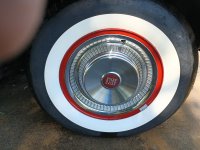Recent content by 322bnh
-
3
1964 Buick 300
Do this. Current recommendations are to use seals on both the intake and exhaust. This will lubricate the guides and stems as good or better than no seals. My 322 showed no wear after 120K miles.- 322bnh
- Post #4
- Forum: Small Block 215, 300, 340 (and Rover V-8)
-
3
1966 401 thermostat gasket
If the old gasket is mostly intact use your scanner with plastic on both sides. Scan and save then set the print dialogue to print actual size. Glue to gasket paper and cut out. Or scan the housing to get the pattern.- 322bnh
- Post #7
- Forum: Nailhead: 264, 322, 364, 401, 425
-
3
62 lesabre with odd compression readings. (50-60psi)
If the timing chain jumped and someone adjusted it to run, the the timing marks will be way off. I had one like that and the top piston rings were all broken due to severe wear with taper in the cylinders causing the rings to flex; it also had a ridge at the top and bottom of the cylinders.- 322bnh
- Post #6
- Forum: Nailhead: 264, 322, 364, 401, 425
-
3
52 263 Head Remove/Reinstall
HERE Get the proper tool to remove the stud- 322bnh
- Post #24
- Forum: Straight Eights!
-
3
1960 Lesabre LS swap
"Anybody can have an LS...not everybody can have a nailhead":oops:- 322bnh
- Post #6
- Forum: Swaps, Engines, Transmissions, and
-
3
Dynaflow issue
Would not hurt to try that and/or STP to raise the viscosity. Modern tranny fluid is less viscose than original and work well in a newly rebuilt transmission, but old and worn ones revolt.- 322bnh
- Post #6
- Forum: Transmissions and Drivelines...
-
3
rear shocks on 54,
Good for you, but I would not recommend it. Use the specified hydraulic jack oil and it will serve you well. Motorcycle fork oil it too thick and you will break the (expensive) links.- 322bnh
- Post #2
- Forum: Transmissions and Drivelines...
-
3
For Sale: Tires 225-75r15
322bnh submitted a new listing: For Sale: Tires 225-75r15 - For Sale: Tires 225-75r15 View the entire listing here...- 322bnh
- Thread
- Replies: 0
- Forum: Buying, Selling, Wanted, Ebay, Etc.
-

For Sale: Tires 225-75r15
Made by Diamondback Radial DB1 line. 4 tires 225-75r15, 2.5 inch whitewall. Six months old and less than 1000 miles. $650 Pickup at zip 78155 or I can deliver to your shipper of choice within 30 miles. $600 (that is 1/2 original price)...offers? -
3
1950 Roadmaster steering effort
Set those radials at 35 psi and sit closer to the steering wheel (as your belly allows).- 322bnh
- Post #13
- Forum: Steering and Brakes
-
3
full synthetic trans fluid use in a 1963 riv dynoflow
Service manual will show you how. As a test with the car on jackstands disconnect the linage at the transmission and run it through the gears at the transmission (assuming detents are in the transmission). While on jackstands check the pressures as outlined in the service manual.- 322bnh
- Post #7
- Forum: Transmissions and Drivelines...
-
3
425 nailhead does not idle
Worn throttle shafts/bushings. Spray the area to check.- 322bnh
- Post #7
- Forum: Fuel Systems, Intake to Exhaust
-
3
Advice Sought: 1950 46D first start in nearly 30 years
Crank it with the plugs out until it shows pressure on the gauge. I have found some of those engines too stiff for that, so tow it in gear for a few blocks.- 322bnh
- Post #4
- Forum: Straight Eights!
-
3
1950 Roadmaster is hard to start.
Don't worry Ben, no pissin' contest this time:).- 322bnh
- Post #14
- Forum: Straight Eights!
